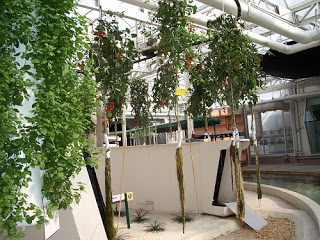 I might seem a little controversial in this discussion of “What is Aeroponics?” However, someone needs to clear up the misconceptions being preached.
I might seem a little controversial in this discussion of “What is Aeroponics?” However, someone needs to clear up the misconceptions being preached.
The term is used way too freely by those who either don’t know what they are talking about or who are trying to sell you on hype.
The True Meaning of Aeroponics
So let’s get to the true root meaning of what aeroponics is. The word Aeroponics is derived from two Latin words meaning aero (air) and ponic (work), air at work.
Did you know?
Tower Garden is NOT true aeroponics.
Why?
In other words, the whole plant, roots and all, are suspended in mid air. Simple put the roots are not covered, not buried, not submerged in any form of liquid or matter, they are revealed openly in thin air.
It’s so simple and basic. Why do so many complicate the issue? Because, they have their own agenda to make or they want to profit from it. Please, don’t be taken by such false advertisement.
Good! We got that out of the way. We will return to the definition later. But for now let’s focus on what aeroponics really is.
Grow it Fast! Grow it Big!
Getting right to the point, Aeroponics is the fastest way to grow plants than any other growing method.
Aeroponics is the process of growing plants in thin air where its roots are exposed to a misty environment. No soil or aggregate medium is used to support the plant.
Aeroponic is an advance method of developing plant growth, flowering, fruiting and health for most plant species and cultivators.
Aeroponics is a method of growing plants suspended (hanging) in mid air without the use of soil or any medium. The bare exposed roots get all of their nutrients from the environment it’s in. There are two forms of aeroponics: High Pressure Aeroponics (HPA) and Low Pressure Aeroponics (LPA). Read More
Carbon dioxide in the air is necessary for healthy plant growth. However, oxygen is needed for roots to absorb the nutrients that surround them. True aeroponics is conducted in air enriched with micro-droplets of nutrient water.
Did you know?
The most popular aeroponics system sold on the market is a lie. It’s not aeroponics.
who’s guilty
The Aeroponics system can grow herbs, vegetables and flowers continuously to allow the grower to obtain yields like never before.
You can use me for…
Aeroponics is perfect for indoor gardening, grow rooms and greenhouses. However, it has been used successfully for outdoor growing of large or tall plants.
Which Aeroponics are you talking about? High or Low
This opens another issue about aeroponics. There are two types or forms of aeroponic systems. The first one is HPA (High Pressure Aeroponics), and the other is LPA (Low Pressure Aeroponics).
HPAs are considered to be True Aeroponics and was used by NASA to grow vegetables. It also is the most expensive and the most complicated growing system to build. However, HPAs use less resources for plant grow: 98% less water, 60% less fertilizer, and 100% less pesticides (no pesticides), all supported by NASA laboratory studies.
LPAs are lower cost system. LPA systems are the most common used and built by DIYers.
High Pressure Aeroponics is True
The HPA (True Aeroponics) system was revolutionized by NASA in the 1990’s by reporting it as the most efficient way to grow plants in space. Studies have shown many benefits of growing plants with aeroponic techniques on both Earth and in space.
HPA systems must operate at a high pressure, normally above 80 PSI, but ideally at 100 PSI. The high pressure is used to atomize the nutrient water through a small orifice (hole) to create water droplets of 50 microns or less in diameter, in other words a fine mist like hair spray.
One micron is one-millionth of a meter. The average diameter of human hair is 80 microns. So we are talking about a really tiny water drop.
HPA also must run on a much accurate time cycle. HPAs might run 1 to 5 seconds on, and then off for three to five minutes. Specific components are required in controlling the timing interval and creating the proper size mist.
The basic components of a HPA are as follows:
1. High-Pressure water pump
2. Pre-Pressurize Accumulator Tank
3. Electrical-Solenoid hooked to an adjustable relay timer
4. Pressure switch
5. Mister nozzles
Low Pressure Aeroponics is Cheaper
LPA systems use a standard magdrive pump couple to some PVC or tubing, and a few miniature sprinkler heads. The water spray from an LPA sprinkler head has large droplets that drown the plant roots.
LPAs generally run the pump 24 hours and 7 days a week, continually wetting the roots. This works well, and are cheap and easy to build. However they are not as efficient as HPA systems.
Also, for this to be truly an aeroponics system the reservoir most be separated from the grow chamber of the plants.
The basic components of a LPA are as follows:
1. High flow water pump
2. Micro sprinklers
Aeroponic systems on the market
Getting back to the definition of Aeroponics: Air at work – This means the plant roots are suspended in mid air.
Simply put the plant roots are not covered, not buried, not submerged in any liquid or matter; they are openly suspended in thin air.
So if some or all of the roots are sitting in any liquid, then it’s not aeroponics.
Any system using a single container to grow and store nutrients, can’t be aeroponics.
Aerogarden is a Fake
Aerogarden ™ is Not aeroponics – Ginger Booth, the Indoor Salad Lady, calls it a glorified nutrient film technique hydroponics system. It’s sold on the market alluding it’s aeroponics. However, it’s just a twisted hydroponic system. The plant roots are submerged in a pool of water. Guess what? It’s a single container solution.
Tower Garden aeroponic growing system is NOT TRUE
Tower Garden ™ is aeroponics LPA style, it’s not True Aeroponics. The system drips the nutrient over plant roots in a hollow tube. I like Tim Blank the inventor. Due to the Tower Garden being easy to operate and includes a very supportive network, it has become popular with many gardeners. However, it’s overly sold as THE AEROPONIC system which it’s not. The Tower is sold as part of a multi-level-marketing company that became successful providing and healthy choices. Remember, true aeroponics must atomize the nutrient to a fine mist using high pressure.


